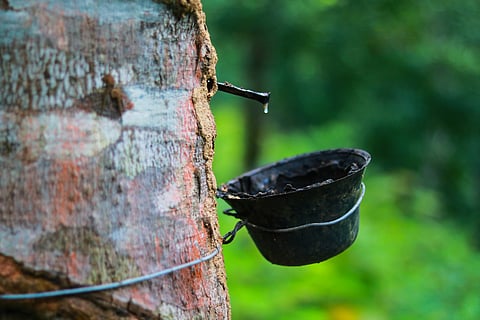

The tropical regions of southeast Asia are known for their rubber plantations and provide the much needed commodity for vital manufacturing processes. However, deforestation and conversion of erstwhile rainforests into rubber plantations is detrimental to the soil, a study has found.
A study published in Environmental Management, November 2024 examined the effect of rainforest conversion into rubber plantations on soil's dissolved organic carbon (DOC) — one of the most mobile organic matter in the terrestrial ecosystem that causes the transformation and migration of carbon.
Researchers found that soil DOC concentration was a whopping 150–200 per cent higher in rubber plantations than in rainforests, with an unchanged pattern across the seasons (dry and rainy) and plantation type (monoculture vs mixed).
DOC production was consistently higher in rubber plantations across seasons. A higher DOC under rubber plantations was also coupled with a greater DOC to dissolved nitrogen ratio.
Reduced soil chemical and biological attributes emerged as main drivers of DOC. Altered carbon-nitrogen stoichiometry encompasses higher DOC leaching in rubber plantations, the study stated.
The sites studied for the research were rubber monoculture, mixed-rubber plantations and a reference rainforest.
The establishment of rubber plantations caused degradation of major soil properties including lowering of several attributes of a healthy soil profile — lowered pH (increased acidity), less electrical conductivity, lower soil organic carbon, less available nitrogen, less phosphorus, lowered total nitrogen and total phosphorus — which were significantly negatively correlated with DOC.
Rubber plantations with high nutrient demands and altered soil properties lead to increased leaching of DOC due to its limited utilisation by microbes.
The study emphasised the importance of robust and sustainable soil management, such as optimising plant density and legume intercropping in rubber plantations to improve soil health and minimise DOC leaching and its potential environmental consequences.
Ashutosh Kumar Singh, a professor at the Chinese Academy of Sciences was the lead author of the study which was conducted at the northern edge of the humid tropical landscape in south-east Asia in China’s Xishuangbanna which is a major rubber cultivation base.
The rubber plantations (mostly monoculture) in the region covered 22 per cent (424,000 hectare) of the total landscape, a significant proportion of which has been established by replacing native rainforests. This has resulted in rainforest barely remaining 3.6 per cent of the region.
Additionally, a June 2023 study (Yong Liu & et al) showed that the conversion of forest to rubber plantation significantly reduced DOC, microbial carbon (MBC), total nitrogen and total magnesium pools by 24 per cent, 35 per cent, 13 per cent and 94 per cent respectively.
While rubber intercropping with different crops profoundly increased the DOC and MBC pools by 6 per cent and 24 per cent on average, respectively.
The transition of rainforests to rubber plantations leads to significant changes in the quantity and quality of organic matter input to the soil. This in turn changes the physicochemical and biochemical soil properties, with a pronounced impact on topsoil layers.